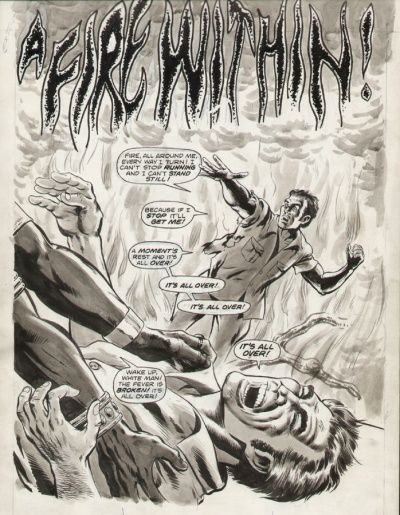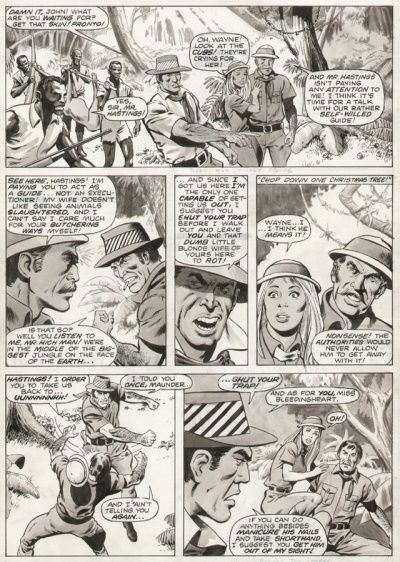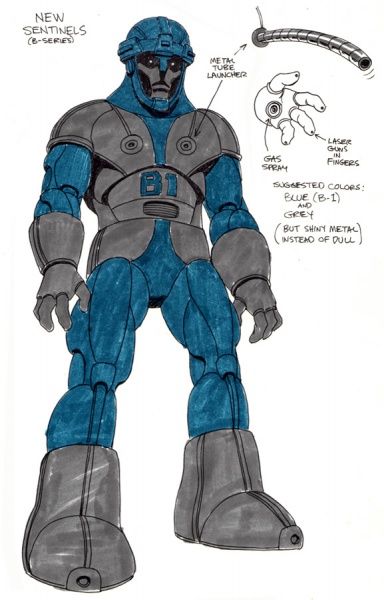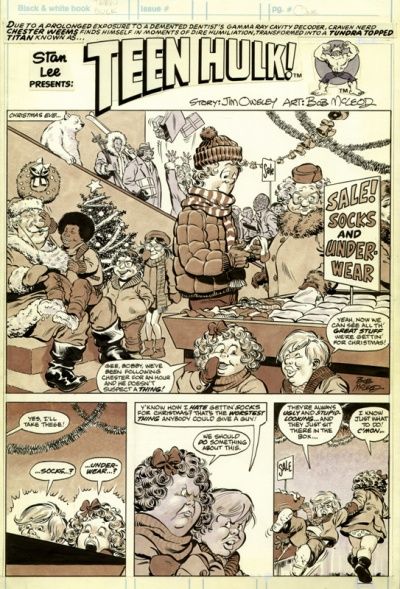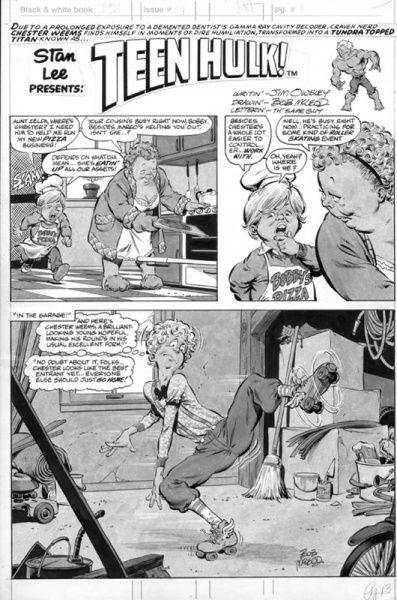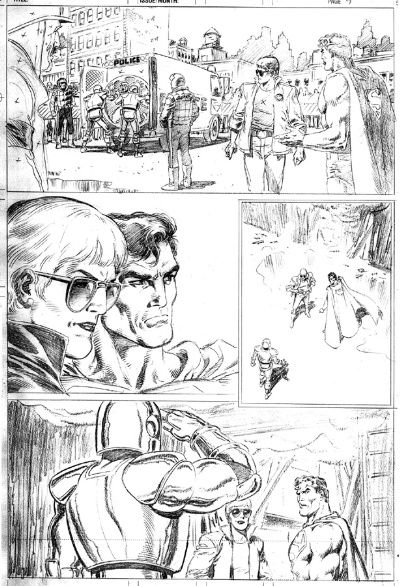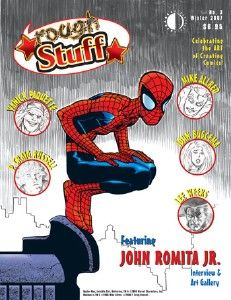Laying it on the line(s)
A career appreciation of Bob McLeod
by Drew Geraci
Since I was seven years old, I wanted to be a comic book writer/artist. It was my only passion, so I devoted (perhaps too many) hours reading and studying all the nuances that made a comic book. Art was always my main interest, because for this '70's child, a lot of the stories were way over my head, whether it be a Steve Gerber text page or anything by Don McGregor. I was initially confused when seeing my favorite artists (pencillers then were credited as 'artist', the inker, just 'inker') do stunning work one month, then see the same artist's work appear ugly and sketchy the next. It didn't take long for me to deduce the reason: The only difference on the credits page was the inker's name.
Pencil and ink are two different disciplines and mediums completely. I still had favorite pencillers, but the inkers, particularly the good ones, caught my attention. Anything inked by Giordano, Adams, Giacoia, McLauchlin, Romita, Sinnott, Janson, Anderson, Austin, Wood, Palmer, Layton and the subject of this retrospective, Bob McLeod, showed me how good comics can look when I wanted to impress a non-comics fan.
I began corresponding with Bob McLeod last year when I felt compelled to contact him via email, thanking him for making Rough Stuff #1 (as Editor for the publisher, TwoMorrows) such a terrific comics-loving experience.
Bob asked if he could publish my missive in RS #2's letters page, and I agreed. Since then, I'd had some dealings with TwoMorrows, such as contributing a scan for Modern Masters: Kevin Maguire. This fueled my inner geek, and I began offering Bob some photocopies of pencils from various books I've worked on, and we began a friendly dialogue. Then it occurred to me: Bob probably has some great stories, having a decade or two on me in the funnybook biz. I asked Bob if I could interview him, and coincidentally, CBR's own Brian Cronin had just invited me to submit an article or blog. The planets aligned, and here we are!
Drew Geraci: How is your name pronounced?
Bob Mcleod: It's easy: Bahb. Oh, you mean my last name? Sorry, I couldn't resist. Not like it's spelled, and not like a cloud. It's Scottish, so if you pronounce it with a Scottish accent, it sounds obvious. Think of it like a loud noise. mac-LOUD.
DG: It reminds me of Dennis Weaver's TV character, McCloud, and how the police captain always yelled at him: "Mac-LOUD!"
DG: How did you break into this crazy business? Did you start as an assistant?
BMc: That's quite a story, which you can read about on my web site at www.bobmcleod.com/start.html , but basically, after spending the summer doing sample page after sample page and getting nowhere, I finally met Neal Adams, who called Marvel and got me the job in production. With my foot in the door, I was later able to get freelance work.
DG: What was your first professional work? The earliest I can peg you down is Defenders #24. I remember, even as a wee lad, seeing how three-dimensional your inks were on regular penciller Sal Buscema. No disrespect to Sal Trapani, Jim Mooney or others, but at the time, I felt you and Klaus Janson were the only ones who could elevate Sal's art to stand shoulder-to-shoulder with the 'hot' pencillers of the time.
BMc: I started in the production dept. at Marvel, doing lettering corrections and then art corrections. I added grey tones to several jobs in the black and white magazines. My very first comic art job was penciling and inking a satire of the movie West World for Marvel's Crazy magazine. As a kid, I wasn't into superheroes, I was into Mad magazine and especially the work of Mort Drucker. I continued to do a lot of penciling and inking for Crazy, and I started inking backgrounds for Esposito, Janson, and Milgrom. Then I inked a job with wash tones over Don Heck for one of the black & white mags but it was never published. I inked a few more jobs for the magazines, then finally inked a color comic, Kazar #7, over John Buscema's breakdowns. Then I inked Frankenstein#16 over Val Mayerick, then Son of Satan(Marvel Spotlight #22) over Sal Buscema's breakdowns, and then Defenders #24. Son of Satan was where I finally started to get the hang of inking and people at Marvel liked me over Sal. I looked at what Klaus did with Sal, and tried to compete. I was studying inking constantly, trying to unlock the mysteries of Tom Palmer and Neal Adams.
(click on all images to enlarge)
DG: Don Heck was such an underrated, underappreciated talent, and these pages you've graciously shared with us bear that out.
BMc: Yes, I always liked Don's work. I enjoyed inking that job, and wish I could have done more over him.
DG: I thought you did exceptional work on the late John Buscema's Conan during the post-Roy Thomas period. What was it like inking Buscema? From his interviews, I got the impression that he could be a malcontent about inkers, wishing he could always ink his own stuff, but Marvel needed his dramatic pencilling more. Did you have any phone conversations with him or was it just a job?
BMc: He was my favorite penciler to ink, because he gave the inker the most to do. All he supplied was the bare bones layout. I would gladly have inked him for years, but a project called The New Mutants came along. I met him up at the Marvel office once. Stan had him come in and try to teach us newbies how to draw faster. He probably didn't care for my inks, because I didn't ink him in the Fosterish school he preferred. I was too influenced by Palmer and Adams. If I had it to do over, I probably would ink it closer to his own style. I never had any phone conversations with anyone I inked, that I remember. My attitude was that I should just make the job the best it could be. If the penciler wanted to be traced, he should ink it himself. I didn't like anyone telling me how to ink. Most of the pencils I inked were loose and needed a lot of help from the inker.
DG: You pencilled AND inked not only one of Marvel's first Graphic Novels, but the first X-Men spinoff team ever, New Mutants! This lead to your work on the initial ongoing series, which came out immediately after the NMGN. Why did you only do the first few issues?
BMc: That was the first regular book I had pencilled, and I just couldn't draw fast enough to meet my own standards. After rushing through the graphic novel, I immediately had to pencil the first issue of the series. There were many fewer inkers working in comics at that time than there are today. I gave them a list of 10 inkers I'd prefer to work with, adding Mike Gustovich just to round out the list to 10. Just as it took me years to become a good inker, Mike was a very weak, inexperienced inker back then, though I think he's improved tremendously since then. After 3 issues of very rushed pencils and very weak inking, I had had enough, and asked to be switched to inker, because I figured I could better control the look of the book by inking breakdowns over another artist. And that worked initially, but then we started having to do stupid things like put Team America in the book, and while Sal Buscema is a very talented artist, he was probably pencilling 2 or 3 books a month, using mostly straight-on medium shots because he didn't have time to think of more interesting layouts, and I decided I wanted to do more with my art than just ink a boring book over rushed layouts. I very reluctantly left the New Mutants after inking issue #8. It was a stupid decision, I know. I can't think of another penciller who has quit a series just because he didn't like the inker. But I had done so much inking that the finished look of the art was very important to me. It's the same reason I later quit pencilling Superman in Action Comics. But the New Mutants were my babies, and I just didn't want to do them if I couldn't do them right.
DG: It's been alleged that both the NM graphic novel and series were scheduled too soon after being greenlit. Was it a situation similar to the first Punisher miniseries (by Grant/Zeck/Beatty), where the book was "late" before it began (leading to a fill-in team to complete the final Punisher chapter)?
BMc: Yes. It was originally just supposed to be a regular comic. Then, after I had begun pencilling a few pages, they decided to make it a graphic novel, but the novels were on a different production schedule, and they needed 50 pages right away, ASAP. Marvel stupidly scheduled the graphic novels and then scrambled to find projects to put into them, rather than at least getting projects assigned and underway first and then scheduling them. I wanted to pencil and ink the graphic novel, but there was really no time. This was one of my first pencilling jobs. I had very little experience and really needed more time to think and work on the layouts, but they needed to meet the printing schedule so I had to draw it as fast as I possibly could. Coincidentally, in addition to getting my first major pencilling assignment, I was also getting married right then, and had already planned a honeymoon when they said a certain other inker was going to ink it if I didn't have time, because they needed it right away. I knew he wouldn't give it the look I wanted, and I had seen him do inking I didn't like on some other projects. So I decided it was too important and I had to ink it myself. I worked through my honeymoon, inking as quickly as I could move the pen. The result was a 2nd rate job, unfortunately.
DG: In New Mutants, I really liked your redesign of the Sentinels (blue & gray, instead of the two-tone purple). Tell me your thinking behind that. Was it suggested, or was it an artistic impulse?
BMc: They asked me to come up with an updated design for the Sentinels. Something new but still similar to the old ones. I changed them in subtle ways and I had always thought pink and purple were ridiculous colors for them, so I suggested blue and grey.
Bob on his Sentinel style guide: "I just drew it for my own use. They didn't request [that I] get it approved."
DG: Far as I can recall, the next time the Sentinels were used, the old purple style resumed. Had your versions popped up anywhere else?
BMc: I know I saw them used somewhere else, but I don't remember where. Marvel was very disorganized in that way, and the next artist and editor were probably totally unaware that I had redesigned them.
DG: About the Sentinels, I conjecture that the reason for resuming the original design and color scheme was because that's how they were shown in the classic Claremont/Bryne/Austin Days of Future Past storyline, which takes place in an apocalyptic future (is there any other kind in comics?). Hence, the Sentinels were back to purple with the chicklets on their heads. Do you agree that could be the reason?
BMc: I don't know. I had moved on to other things, and didn't really pay attention. It wasn't a big deal, where I was trying to make my design THE new Sentinels. It was just something I did for that issue and then forgot about it. It may disappoint you to learn that I'm not a big comic book fan. I love to draw, and I got into comics originally thinking it would be temporary until I moved on to illustration or animation. I stuck with it because it was so challenging, and then the work was very steady and I was making a good living for many years while we were raising a family. I think comics have gotten way too dark and serious and the fun is no longer there. I'm still blown away by the art, but for the most part it's not the art I want to be doing. I had much more fun on my SuperHero ABC book than anything I ever did in comics other than maybe Teen Hulk.
DG: I loved Teen Hulk! Sometimes it was the only reason to buy Crazy Magazine (Marvel's answer to Mad & Cracked, one that lasted a good ten years)! Teen Hulk's been out of my radar, since it's never been reprinted, but now I'll have to scour magazine sections at cons! A digest-sized collection of Teen Hulk would be ideal.
BMc: I had so much fun on that. I would love to see it reprinted.
DG: Since you've just also mentioned Superhero ABC, how has it been received?
BMc: Very well. It's gotten almost all five star reviews from readers on amazon.com, and two starred reviews from top children's book critics. School Library Journal voted it one of the best books of 2006. I've gotten many emails from families who love it. It's also selling very well, and is in its fifth printing, I think. I've written two more children's books I hope to get published soon.
DG: How long did it take to complete Superhero ABC, from conception, to execution, to marketing?
BMc: About eight months working full-time. I would have spent much more time on it, but HarperCollins was rushing me to finish it so they could get it into their fall schedule. I did the art for the first two letters and wrote the preliminary text for the rest of the book and sent it off to several publishers. HarperCollins called about six weeks later and offered me a contract. I totally redid several pages as I got better ideas and as I made several of them into double page spreads.
DG: Who was your favorite editor to work with, and why?
BMc: Mike Carlin, when I was penciling Action Comics. He was such a good editor. He knew exactly what to tell me to make my work better. He was there when I needed him and stayed out of my way when I didn't. He knew what he was talking about and was very competent at his job. He had a very informed opinion. It was such a pleasure working with him.
DG: Comic fans may not realize this, but many inking assignments have called for 'ghosting', uncredited assistance on backgrounds from fellow pros (or any warm body in the room) to meet tight deadlines. Do you have any crazy stories involving 'jam' issues?
BMc: I wouldn't call them crazy stories, but I've been involved in far too many to mention. I was also one of the regular Crusty Bunkers, a group of artists who inked comics under the direction of Neal Adams. Neal would get a job, and be responsible for maintaining a certain level of quality, and he'd pay us his inking rate, split up among everyone who worked on the job. It was very piecemeal, with each person often just inking an arm or a leg or parts of backgrounds. We were all in Neal's studio, and we just passed the pages around, letting people ink whatever they wanted. Neal had dibs on the main figures and told us beginners to mainly do backgrounds, but we also did secondary figures. It was a great experience.
I also ghosted a few of pages of Secret Wars for John Beatty (the last four from #6). The deadline was very tight, and I bet him and Zeck I could ink a page in three hours with no loss of quality, and I won the bet (page 21 of #9--I also inked the cover).
DG: When I started collecting comics, I was initially a Marvel Zombie. That said, I tend to associate you with a lot of Marvel projects, but which of the "Big Two" comics companies have you spent most of your career inking? Also, any Image, Dark Horse or other comic publishers you'd like a crack at?
BMc: Actually, I've probably done an equal amount at both Marvel and DC. Early on, among other things, I inked some memorable Legion of Superheroes comics over Jim Sherman, a few Society of Super Villains over Buckler and Arvell Jones, a couple Karate Kid over Juan Ortiz, several Firestorm issues over Milgrom, and two Aquaman comics over Don Newton. Then later on I was regular inker on The New Titans and Wonder Woman over Perez, Detective Comics over Nolan, Wonder Woman again over Paquette, Jemm Son of Saturn over Colan, Psyba Rats over Dutkiewicz, and I pencilled Action Comics for two years, also inking several issues, and I inked a 54 page Legends of the DC Universe: Crisis #1 over Paul Ryan. I penciled and inked a job for Dark Horse, and penciled and inked a couple for Pacific Comics, inked the Visitor for Acclaim, inked Mister Hero for Tekno Comics, and penciled and inked Freemind for Future Comics. The only thing I regret not getting to do is I would have liked to pencil a Batman job, though I did draw him in Action #654.
DG: The late Don Newton was finally given a respectable tribute in Back Issue #19 How was it inking him? I honestly consider his elegant style the genesis of the Alan Davis look.
BMc: Don was great to ink over. He was doing some more interesting lighting than most pencilers at that time, and the work looked very attractive and solid if you inked it well. I wish I had inked more over him.
DG: Gene Colan on Jemm: Fun or pain-in-the butt to ink? I've only done some commissions over Gene's pencils, and I was fortunate to have a flexible deadline as it took me weeks of staring at it, trying to resolve how to make his halftone grays into black graphics.
BMc: I've always totally enjoyed inking Colan. I also inked him with grey wash tones on Howard the Duck and Dracula. That's really the best way to go with Gene. I've sometimes used zipatone for his greys, as Palmer used to do lot, but I usually try to interpret his greys with crosshatching or scribbling. Trying to interpret those greys is the fun of inking Gene. I saw Neal Adams ink some Colan panels ghosting on a Leialoha Howard the Duck job, and Neal just used a lot of linework in the grey areas, so I was influenced by that.
DG: Speaking of the legendary Tom Palmer, how was your experience on Marvel's Star Wars, when he inked YOUR pencils?
BMc: Tom is my favorite inker, and he was already on the book when I came on as penciler. He asked for breakdowns, which I was happy to do, because I wanted to study what he did from layout to finish. I learned a lot. He did a lot of lighting I wouldn't have thought of, and has a more realistic approach to faces than I do. With my Mort Drucker influence, I often tend toward a more cartoony look. Tom is also excellent at Wookie fur. I thought we made a great team.
DG: You later inked Dale Keown on the Hulk during one of his most eventful transformations (Hulk's, not Dales), and I've contended that his work never looked better than when you or Mark Farmer inked him. What was that experience like?
BMc: Dale was a pleasure right from the start. His work had a nice warm feel to it, and it was fun to ink. As we went on, he began to trust me to finish up anything he was too rushed to develop fully, and I took over in a lot of areas. But mostly I was just trying to keep that same lush feel the pencils had. I think Mark Farmer, who took over after I left, did a great job. He used a brush, where I was using mostly pen, so it had a heavier feel.
DG: In the early 1990's you pencilled one of the many Venom miniseries, Venom: The Enemy Within. Was he a tough title character to work up enthusiasm for (being that he was so overexposed at that time)? It appeared to me that you may have shifted your style a bit. Were there pressures to go for the then-hot Image style?
BMc: Yes, there was actually a lot of pressure to adopt an Image look. I tried to blend it into my own style, though. There's plenty of my style in the lighting and drawing. In fact, I think there's some of my best work in parts of that mini-series. I particularly like the first three pages. And the two-page sequence of Hobgoblin crashing in on the acolytes I had fun on. Take another look at the second issue. There's a lot of my style in there. I hated the Venom character, but did my best with it. I pencilled and inked the first two Venoms. The 3rd Venom was a rush job because I had lavished so much time on the first two, and of course Marvel always schedules issues before they're completed (usually before they're assigned!). Loose pencils and inked horribly by a novice inker. I inked the last two pages myself. That's how the whole issue should have looked.
DG: Did you ever ink Gil Kane? If so, how was the experience?
BMc: I inked him on one cover, a couple pages of the Superman wedding issue, and I recently inked an unpublished Spider-Man page as a commission. He was great to ink. He gave the inker lots of room to play. I wish I could have done more.
DG: You've been pigeonholed as an inker primarily, but when you've pencilled, how do you like or dislike other inkers on your stuff?
BMc: I know I'm better known as an inker, but I've always done a lot of penciling as well. I penciled and inked several fill-in issues on various titles, I penciled runs on Star Wars, as we discussed, the New Mutants, and Superman in Action comics. I've been inked by some top inkers, Palmer, Rubinstein, Breeding, and some lesser-known inkers, Gustovich, Candelario and Rodier. For some reason, even if I like their inking on other artists, I just haven't been satisfied with them on my pencils. It has little to do with their inking, though a couple of them were too soft or flat, and didn't make the drawing solid enough. I like a real solid, 3D figure. But it's mostly their drawing. They've mostly all changed the drawing of the faces. Too many inkers misinterpret pencils because they don't draw well enough. I guess I just have a very definite idea of how I want my drawing to look and need to ink it myself. I've always struggled with wanting to do both penciling and inking and being continually foiled by deadlines.
An example of good storytelling 101 from Action Comics #672
DG: In 2000, you pencilled a beautiful Hawkman & Hawkgirl short story in Legends of The DCU 80-Page Giant. Even thought it was a Silver Age-era story, I think you had the misfortune of drawing characters that were 'homeless' at that time, until Geoff Johns retooled and popularized them. Would you ever revisit the characters, given the chance?
BMc: Thanks, but I'd rather not. I wasn't at all comfortable doing those characters. Of all the jobs I've done, I'm very surprised you would single out that one. But I'm glad you like it.
DG: Do you wish to discuss what went wrong with Future Comics? Was it the old saw about money running out? I noticed you switched hats on Freemind. An inker one issue, a penciller another. For the record, I thought Freemind had potential, but even with 28 pages of story (six more than the industry standard 22), asking $3.50 for a new book in 2003 shot Future Comics in the foot, IMHO.
BMc: I'm not a businessman, I'm an artist. I don't know why they failed. I just didn't like their books. I respect Giordano and Layton a lot. Bob Layton helped me get work at DC after my career had stalled early on when the Black Panther was cancelled at Marvel, and I owe him for that. But Future Comics was everything I hated about comics: complex backgrounds requiring a lot of reference, unattractive characters, etc. I switched from penciling to inking because I just couldn't stand to draw that stuff. The penciler they gave me did nothing to improve the situation. I left to do other stuff and they later collapsed.
DG: Have you changed inking tools over the years? Let's get technical for the readers at home...
BMc: The quality of inking tools has steadily declined in the last few decades. To begin with, The paper supplied by Marvel and DC was much better in the 70's than in later years. I started inking using the same nib Neal Adams used, the Gillotte 290. That was a wonderful nib that had a great flex. Rubenstein and I then began searching for a nib that would give us a brushy pen line like Palmer had. He was secretive about his nib, saying it was some point he bought hundreds of and wasn't available anymore. We settled on the Hunt 103, which was extremely flexible and terribly difficult to control, but you could get a real brushy look with it. Joe said Neal tried it and told him he couldn't ink with it. Joe and I both used that for several years. Then when Image came along, everyone wanted a more crisp look. The Hunt 102 became the standard. I use that now, but I've moved to using much more brush than I used to. I've always used the Windsor-Newton series 7 #3, but in recent years the quality has declined, and I got some of the Raphael 8404's, which is what I'm using at the moment. But it doesn't have the same wispy feel of the WN. You just can't do the same kind of line work with it. In addition, india ink has gone to hell. I use Pelikan, but I can't find any ink as good as it was in the 70's.
DG: I agree 100% about the decline in art supply quality, particularly ink! Pelikan is my choice as well, but by default.
DG: This question calls for one of my typical indulgent rambles...We've both jumped around a lot on the comicbook landscape, art collaborating with many new and old pros, while many inkers are known for years as primarily one-half of an "art team" with the same penciller. For periods of time, I've been one-half of an art team before being pulled apart by one reason or another (usually conflicting assignments from different companies, but sometime clashes in artistic temperments). When I get a new penciller/assignment, the personal connection I've developed with the previous penciller tends to drift away, except at the rare phone call or convention. When I'm part of a new ongoing partnership, I tend to deal with the penciller on a more personal level, through lengthy phone calls or daily emails. Now that I've selfishly told you all about myself, who would you consider your closest professional relationship in your career?
BMc: Does being engaged to Jim Shooter's secretary count? After the first six years, when I lived in and around New York City, I moved to Florida for ten years, and I now live in Pennsylvania. I've never socialized much with other comics people except when I was starting out, working in production at Marvel and working at Neal's studio. I hung out with Mike Zeck and John Beatty for a time, and Joe Rubinstein, and a few others, but for whatever reason I haven't really maintained any close ties with anyone in comics.
DG: I loveloveLOVE Rough Stuff Magazine! The quarterly schedule is a torturous wait for me! How did you get the editorial chores? And what goodness can we expect in the future?
BMc: I had sent a big batch of xeroxes to Back Issue, when I read they were looking for material for the Rough Stuff feature they had, and I wrote an article for them about inking "rough" pencils. That issue evidently got a lot of good response, and they coincidentally at that time were looking to spin their Rough Stuff feature into it's own magazine. They offered me the job, but I was reluctant to take it at first, because I wasn't a writer and had no editing experience, and really don't work in comics anymore and had been distancing myself from the business to pursue work in children's books, but in the end I decided to give it a try. The first three issues, especially #1 and #3, have had a lot of input from me in them because I didn't have anyone else to write articles and do interviews. Now I'm trying to delegate more stuff to other people. So there are articles and interviews coming up by other people. I'm cutting back on the number of artists per issue, to allow us to give a more in-depth look at each artist, and I'm encouraging them to write longer comments to give more insight into how they think, and also add more reading material to the magazine. I want to keep it mainly focused on the art, but I also want readers to have a lot to read. We have a number of great artists coming up in future issues, both old and new, and I'll continue doing my Rough Critique, which has been popular with our readers. Hopefully, the magazine will keep getting better and better as we go.
Bob McLeod's latest issue of Rough Stuff (#3) is still on stands, and #4 will feature Steven Bissette, Gene Colan, Andrew Robinson, Howard Chaykin, John Totleben and more! All issues are still available at www.twomorrows.com .
Drew Geraci is currently working for DC on alternating issues of 52 and WW3 with Patrick Olliffe. To see a McLeod/Geraci unpublished Venom cover, visit www.drewgeraci.com .


